Forget Everything You Think You Know About The Scott G-Series Fly Rod
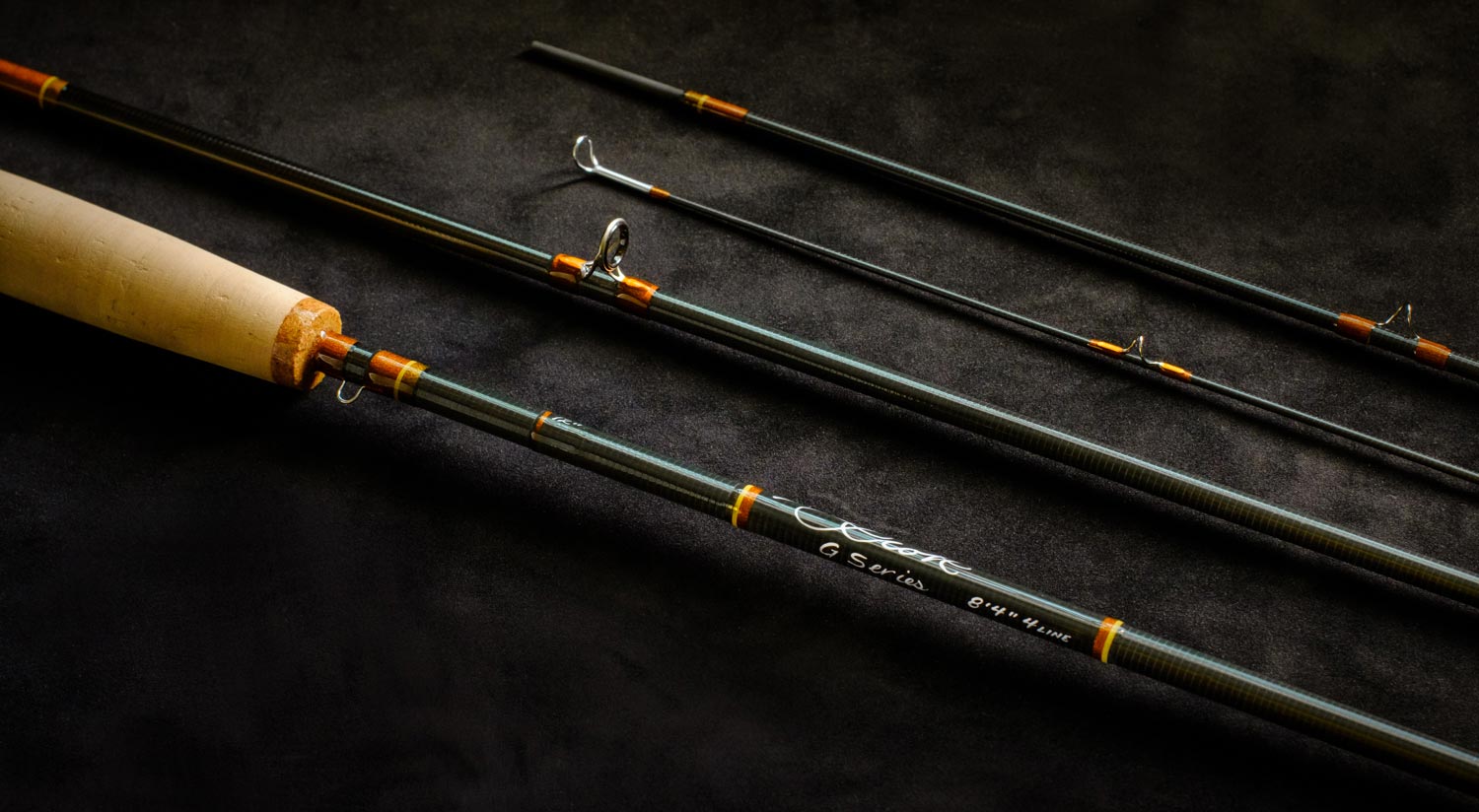
The new G-Series fly rods, from Scott, are a unique and refreshing offering.
The package arrived at my door with a note taped on the outside, saying that I couldn’t tell anyone about what was on the inside. On the one hand, I’m pretty happy to be on that mailing list, but on the other, it has not been an easy secret to keep. I knew this fly rod was something special the moment I picked it up.
It has been widely rumored that something big was coming from Scott this year. With the flagship models, Meridian and Radian, still pretty fresh, there’s been a lot of speculation about what Jim Bartschi has up his sleeve. I don’t know what I was expecting but it wasn’t a new G-Series rod. The first word out of my mouth was, “Brilliant!”
The G rods were first designed in the 1970s. That’s the Jurassic period of graphite fly rod design. The G-2 was introduced in 2006 and I have two of those rods, still in rotation. Eleven years later I assumed that the G was an evolutionary dead end. Like the Neanderthal but with a smoother action. Reviving this rod series at this point in time is both brilliant and refreshing.
The G rods were cutting edge in their day. It was actually the first 9’ 4-weight ever made. They were also the first rods to have internal ferrules. The G series rods have always been the mid-speed line from Scott. By today’s standards the 2006 G-2 is frankly slooooooow. It’s a beautifully casting rod and as good a tool now as ever but the action is more what you might expect from a modern fiberglass rod. They are great technical dry-fly rods, and I love them, but I have always struggled with them on a couple of points. They are not especially good with wind or weight, and for an all-around fly rod, that’s a problem.
Well, the new G-Series rods have nothing to do with that. This new rod looks almost identical to the G-2. Same natural graphite finish with brown and gold whipping. Internal ferrules like the G-2 and the classic grip. Once you slide the sections together and start to flex it, the new G tells a completely different story.
There is a boatload of technology in this rod and it comes together in a completely unique feel. The new G-Series flexes deep and really talks to the caster, by which I mean you know exactly what your line is doing by the feel of the rod. The recovery rate, however, is completely unexpected. This rod will
Read More »The New Jackson Mayfly Kayak

Jackson Kayak is known worldwide for making some of the best kayaks on the planet.
Be it for fishing, whitewater, or freestyle, performance and quality are two words that come to mind when you lay eyes on a Jackson.
Jackson Kayak has been in the fishing game for almost as long as they have been in business. Boats like the Coosa, Cuda, and Big Rig have all been proven on the water as serious fishing platforms. With numerous products available to the kayak angler today, there are a million ways to outfit each of these platforms to best fit your fishing needs. However, one of the techniques that still didn’t have a niche in the kayak industry was fly fishing. Sure, there have been accessories developed to help make toting fly rods a little easier, but that was much of the extent of fly angling accessories. Jackson saw this missed opportunity and has developed a kayak meant to cater to the fly angler. And this thing is ALL ABOUT FLY FISHING!
By now, especially for you kayak fishing enthusiasts, you have probably seen the new Jackson Mayfly on social media platforms, or maybe even on the water. For those of you that haven’t, if you are in the market for a solid fly fishing boat, this is the kayak that you want. For starters, forget all of the little accessories you thought you would need to get started as a fly angler chucking flies from a kayak. There are numerous fly-friendly features that have been thoughtfully built in to the platform of this awesome kayak which take a lot of the headaches out of fly fishing from a kayak.
Going through the kayak, several features have been built in to the Mayfly to accommodate fly equipment. The biggest difference seen on the Mayfly is the modified footrest system. Jackson ditched the pedal-style, side mounted footrest system for a new, center mounted footrest that eliminates line snags while also providing several inches of adjustability forward and aft. If you’re not a fan of footrests, this footrest is easily removed and affords the angler tons of free deck space, and leaves plenty of room for activities. The seat system also gets an upgrade with an adjustable, sliding seat bracket that allows for simple seat position adjustment on the fly. Just forward of the seat, on each side, are two fold-down fly boxes for storing flies on board the Mayfly which are secured with a bungee cord. On each side of the kayak is a new, molded-in, tubular rod storage system that allows you to safely store your rods while fishing, as well as during travel. To coincide with the rod storage, each side also has padded fly reel wells with bungee straps so your fly rod can be stored securely without having to either remove the reel, or place it precariously and hope it doesn’t get damaged. The rod storage system is setup for nine foot rods. Longer rods can be stored on the kayak, however the reels will not sit inside the reel wells. Behind the seat is a large area for storing coolers and other gear. I can easily fit my Orion 35 cooler in this area and still have room for a few smaller pieces of gear or a couple large fly boxes. New latches have been added to the forward and aft storage compartments which provide a solid seal and help keep water out of the hull, and a drop in tray has also been added to the forward compartment to allow easy access to other gear that may come in handy. Just like with many of Jackson’s vessels, there are numerous rails mounted along the kayak to allow for smart placement of various RAM mounted accessories, like
Read More »Sunday Classic / Tapping into your Subconscious Thinking
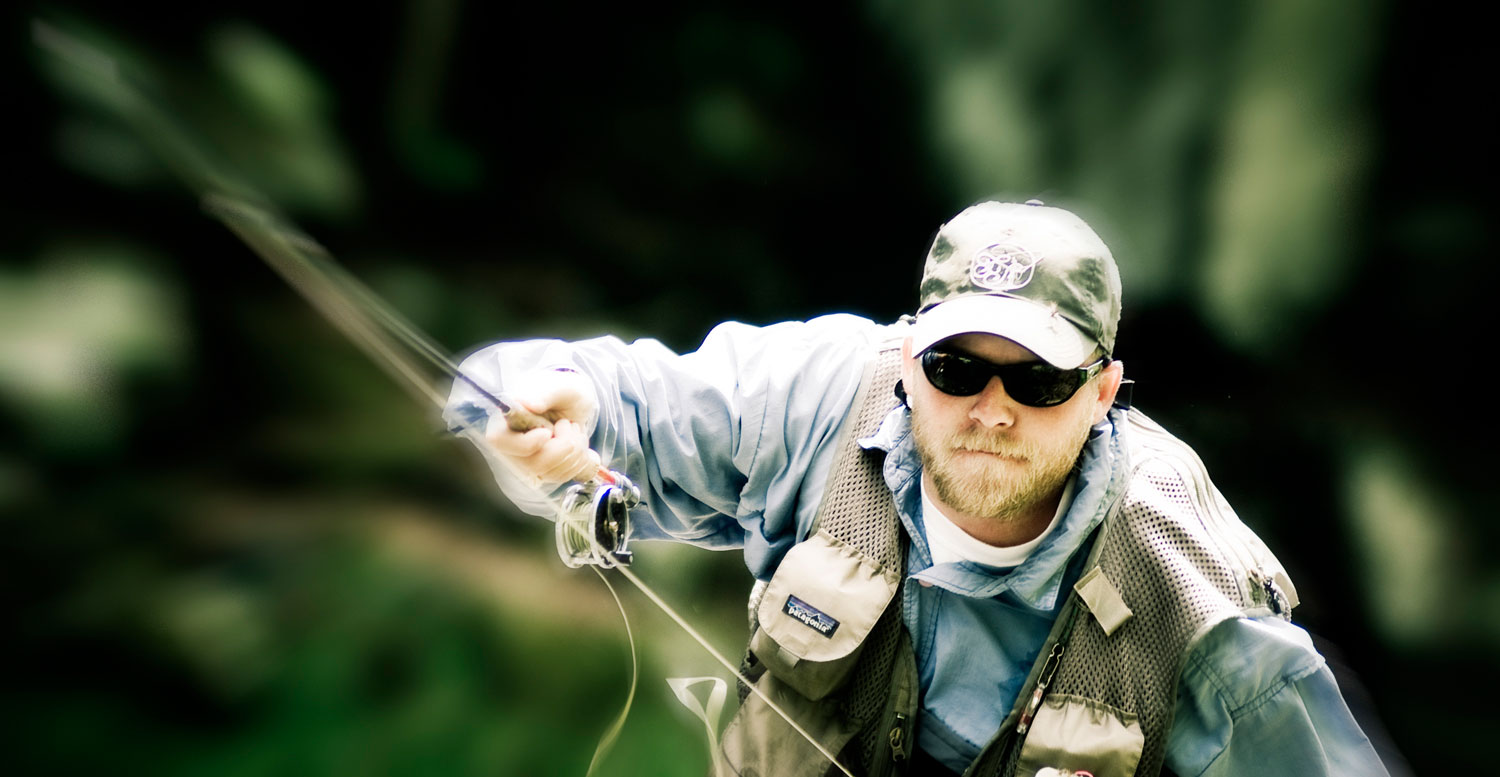
For years, I’ve felt like my subconscious has put me in a zone on the water.
One of the most stimulating and interesting TV shows that I take the time to watch every chance I get is “Through the Wormhole” on the Science Channel. Go ahead and call me a geek, I find the show inspiring and can’t help to think if I’d been forced to watch this show as a kid I’d probably be three times as smart as I am today, and would have made it much further in my advanced education. “Through the Wormhole”, is hosted by the great actor Morgan Freeman, and it runs segments on all facets of life, discussing such topics as advanced science and mathematics, space travel and the human brain. The other day couch surfing and flipping through channels on the TV, I stumbled upon the show and quickly found myself glued to the screen as it talked about the mysteries of our subconscious, and how it’s used every waken moment of our lives.
Neuroscientists have prooved that the human brain constantly uses our subconcious to guide us and sway our decision making. The show talked about how it’s our subconscious that allows musicians to memorize and perform extraordinarily difficult pieces of music perfectly by keeping their mind and muscle control in harmony. I assume it’s very similar to how professional athletes are able to put themselves in a zone during a game by using their subconscious, then making game winning plays. It was explained that our subconscious always stays two steps ahead of our conscious thinking, and that it’s a major driving force that keeps us out of danger and allows us to use our gut feelings to make spontaneous decisions correctly when we lack the information needed. The show went on and on, in great detail about how humans benefit from their sub-conscious, and then backed it all up by doctoral research and testing. In the end, the show concluded that in the future, if humans can learn to regularly tap into their subconscious we’ll be able to be more healthy, become significantly smarter and more creative than we can possibly imagine.
After I finished watching that particular episode of “Through the Wormhole”, I began thinking about what degree our subconscious plays in our fly fishing.
Read More »Saturday Shoutout / Bear Necessities

Summer fishing season brings anglers and bears together and not always for the best.
Bears are a fact of life for fly anglers. Trout country is often bear country and a smart angler will be prepared for a run-in. Most bear encounters which end in an attack happen in close quarters. Bears have poor eye sight and are surprisingly easy to sneak up on. They are also surprisingly quiet and just as often sneak up on you. Most anglers who encounter bears say something like, “I just turned around and there he was.
Luckily most encounters end peacefully. One day, Kent and I were fishing from a gravel bar for a good forty-five minutes. Two other anglers stopped across the river for a while and watched us. We bumped into them later that day and one of them said,
“You boy’s are pretty bold. I can’t believe you just kept fishing with that bear.”
We never even noticed that a bear had wandered onto the gravel bar behind us and was apparently there for some time. We were so focused on fishing that we missed it. Most bears are that generous but once in a while you run into a bad one. Often an adolescent male or sometimes an injured or elderly bear will challenge or even charge a human.
The best way to protect yourself is with bear spray. Statistically spray far out performs a gun in a bear attack. If you carry bear spray you should know how to use it. Below is a link to a great post on the topic from Orvis News. There’s a video too. It’s a little cheesy but has a lot of great information. Have a look at both and stay safe out there.
CLASSIC PRO TIPS: HOW TO STAY SAFE IN BEAR COUNTRY
Read More »Tie Connor’s Jerk Minnow
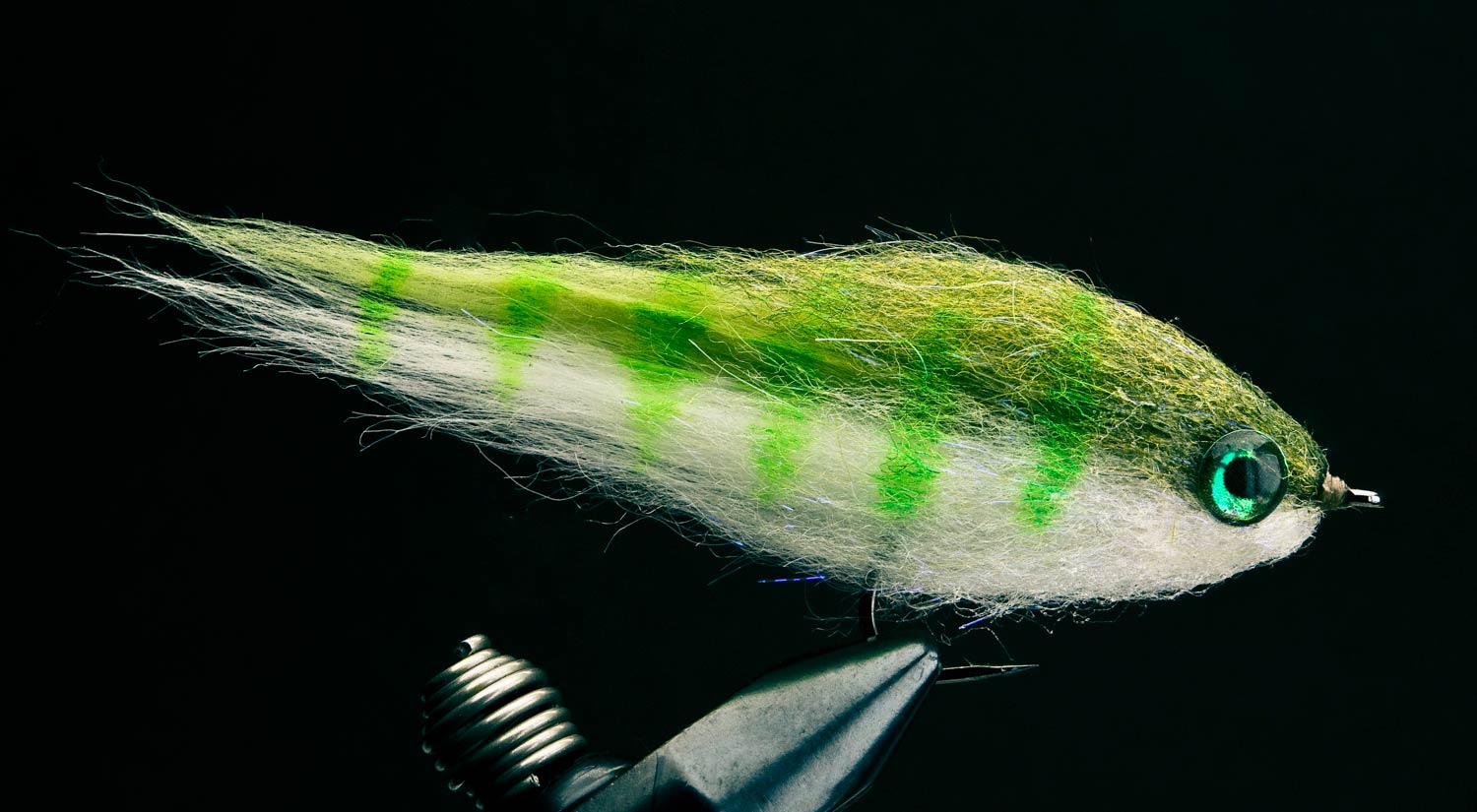
THIS DECEPTIVELY SIMPLE FLY IS ALL ABOUT THE ACTION.
Connor Jones, from Cohutta Fishing Company, ties this versatile baitfish pattern for bass and trout here in the southeast. It’s a simple fly with a clean profile and it’s easy to tie in a variety of colors.
The secret to the jerk minnow is it’s action. Connor builds a hard, hollow head, from Senyo’s Laser dub and Clear Cure Hydro, which captures air and gives the jerk minnow an erratic darting action, when stripped hard. Big predatory fish can’t resist it
It’s a fly that will produce fish on lakes and rivers. Tie it in the colors and size to match the forage species on your local waters. Strip hard and hang on tight!
Watch the video and learn to tie Connor’s Jerk Minnow
Read More »Please Stay Off Your Phone!
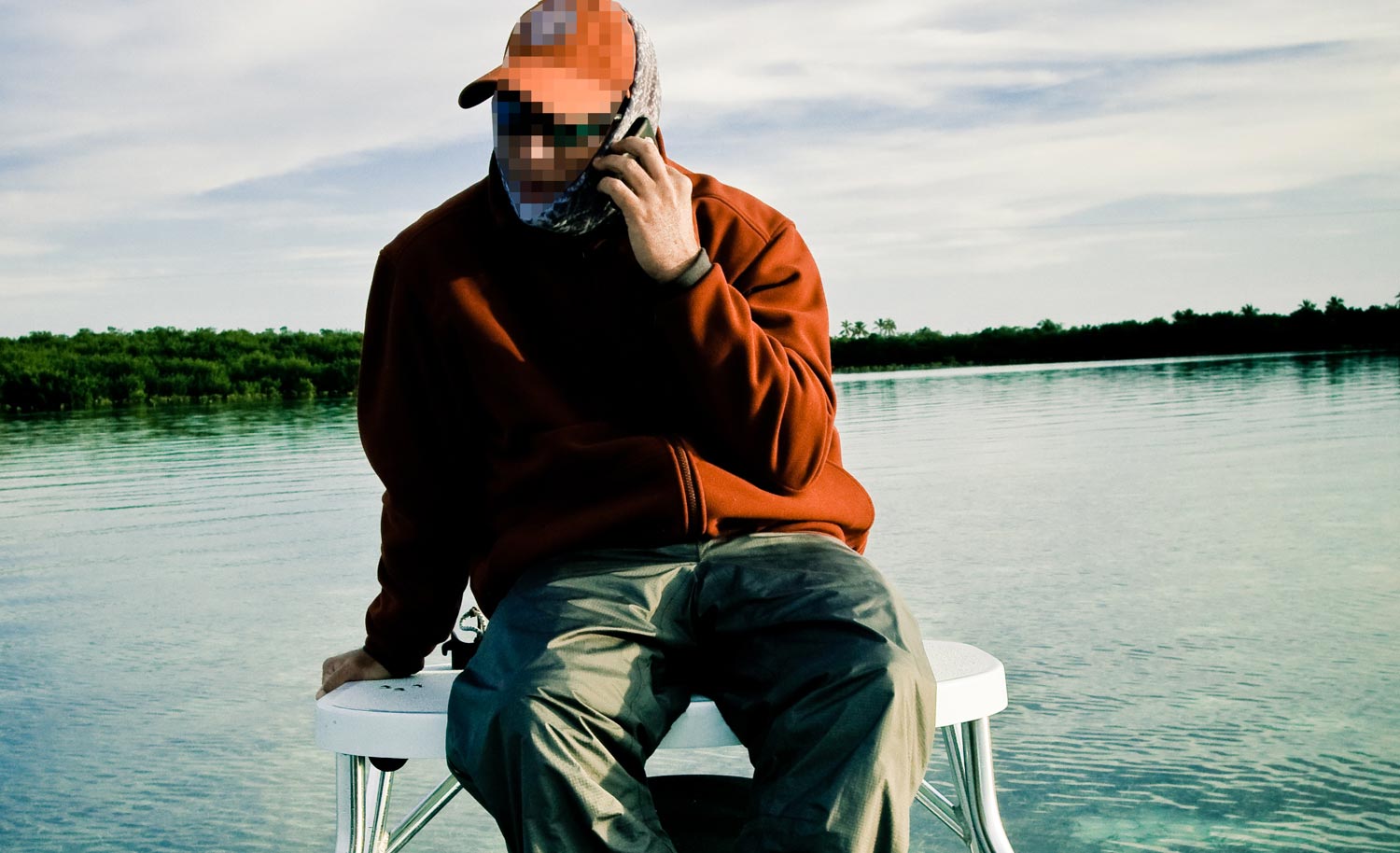
GUIDES, WHETHER FRESHWATER OR SALTWATER, DO YOURSELF A FAVOR AND DO THIS ONE THING WHEN YOU ARE WITH YOUR CLIENTS…
STAY OFF YOUR PHONE!
We have all become used to this “phones-that-do-all” culture. Cell phone technology has made things so convenient, that we forget what it’s like to function without one. I’m not bashing it. In fact, I’ve always got my phone on me. I use it to complete a load of daily tasks. Even when I’m on the water, it’s in my front wader pocket so I can get to it to take the occasional photo. However, when I’m on the water with clients, it stays on vibrate and I don’t take it out.
Nothing will make your client feel less important than looking over to his/her guide to find them engrossed in Facebook or talking with a buddy about their weekend plans. Anglers hire guides to guide them while on the water, not play on their phones and serve as a net man from time to time. Much of this will sound like some pretty common sense stuff to the majority of the folks that will read this, however, there are guides out there that do this exact thing. I’ve heard some pretty impressive displays of guides not giving a damn and it gets my blood boiling. Hiring a guide isn’t cheap. And when folks do hire a guide, they should expect the best from their guide, and to learn from their guide. No client should walk away from a guided trip without having learned something new, regardless of the fishing.
If the call or text conversation has some relevance to the trip that day, then be sure let your client know. Short of an emergency, any other phone calls or texts can wait until either the lunch break, or the end of the day. The only other reason
Read More »The Moth Larva Hatch
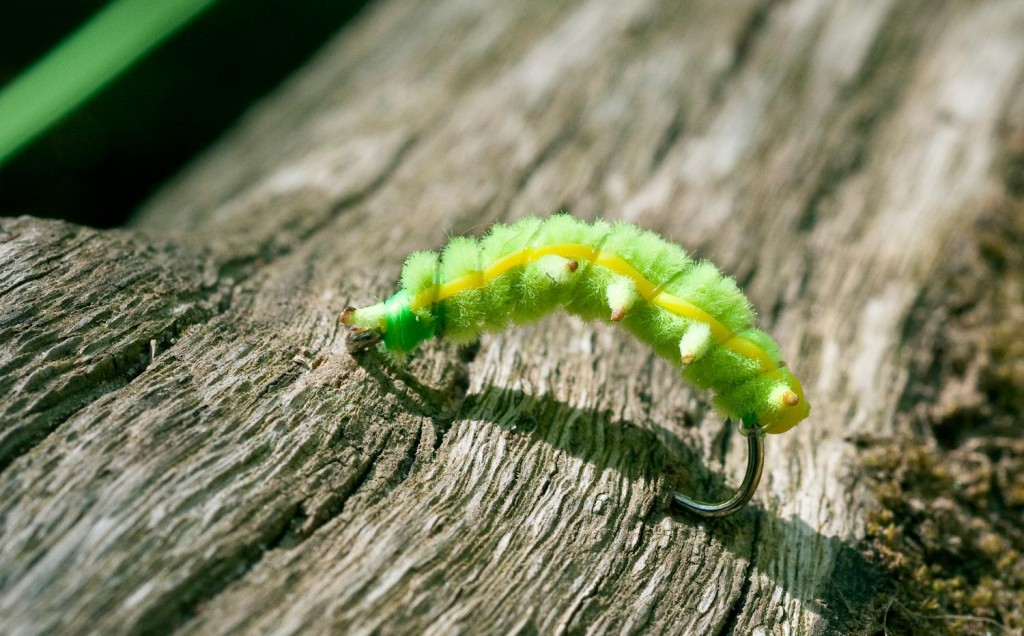
By Kent Klewein
AS I RELIVED LAST YEAR’S SPRING FISHING SEASON IN MY HEAD SEARCHING FOR THE PERFECT HATCH, THE COLOR OF BRIGHT GREEN BEGAN ENTERING MY CONSCIENCE, AND BAM! LIKE A SLAP TO THE FACE, IT HIT ME.
Every year we get a month-long trout feeding frenzy, as moth larva burst onto the scene by the tens of thousands. Yes, I’m talking about the green weenie, the inch worm. The tree limb-repelling caterpillars that every trout in the stream will gorge themselves on through the month of May, and well into summer. Multiple species of moth larva ranging from 1-2″ long annually coordinate a synchronized blanket hatch during late spring that ends up packing the bellies of trout with protein-rich, green gummy goodness. Anglers smart enough to take advantage of this late spring phenomenon can find themselves fooling the biggest trout in their waters.
Timing the Moth Larva Hatch
For the hottest and most consistent fishing, the best time by far to target the moth larva hatch is during it’s early stages. The blanket hatch usually begins the first week of May in North Georgia, but can start a little later depending on how far north you live in the Southeast. Because this hatch unfolds and gains momentum so quickly, it takes very little time for trout to recognize the new food source and begin keying in on it. As soon as I spot the first moth larva of the year, I begin working the larva imitations into my fishing within days. This way I can monitor their effectiveness, and do a much better job of timing the hatch during its peak periods. When most of the trees have gotten the new years foliage, you should start anticipating the hatch to begin.
Fishing the Moth Larva Hatch
There’s basically three ways you can go about fishing the moth larva. The best technique and rig depends on the size and depth of water you’re fishing. It’s also very important to pay attention to how the fish are feeding on the hatch (surface or subsurface), and where you’re locating the concentrations of trout. Here are the two main rigs I use when I’m zeroing in on the moth larva hatch:
Rig 1. Buoyant Dry Fly with Inch-worm Dropper
You can fish a floating inch worm pattern solo like a dry fly. Most of these patterns are tied out of deer hair or foam. They float well, but it can be hard to find the correct shade of tying materials to match the color of the naturals. Because of this, I generally opt for dropping a simple, bright green ultra-chenille inch worm pattern 18-20″ off the back of a buoyant dry fly. You can tie them up in a third of the time of the deer hair patterns, and if you add floating, it floats well enough.
This rig works really well on small streams where
Read More »Happy Independence Day
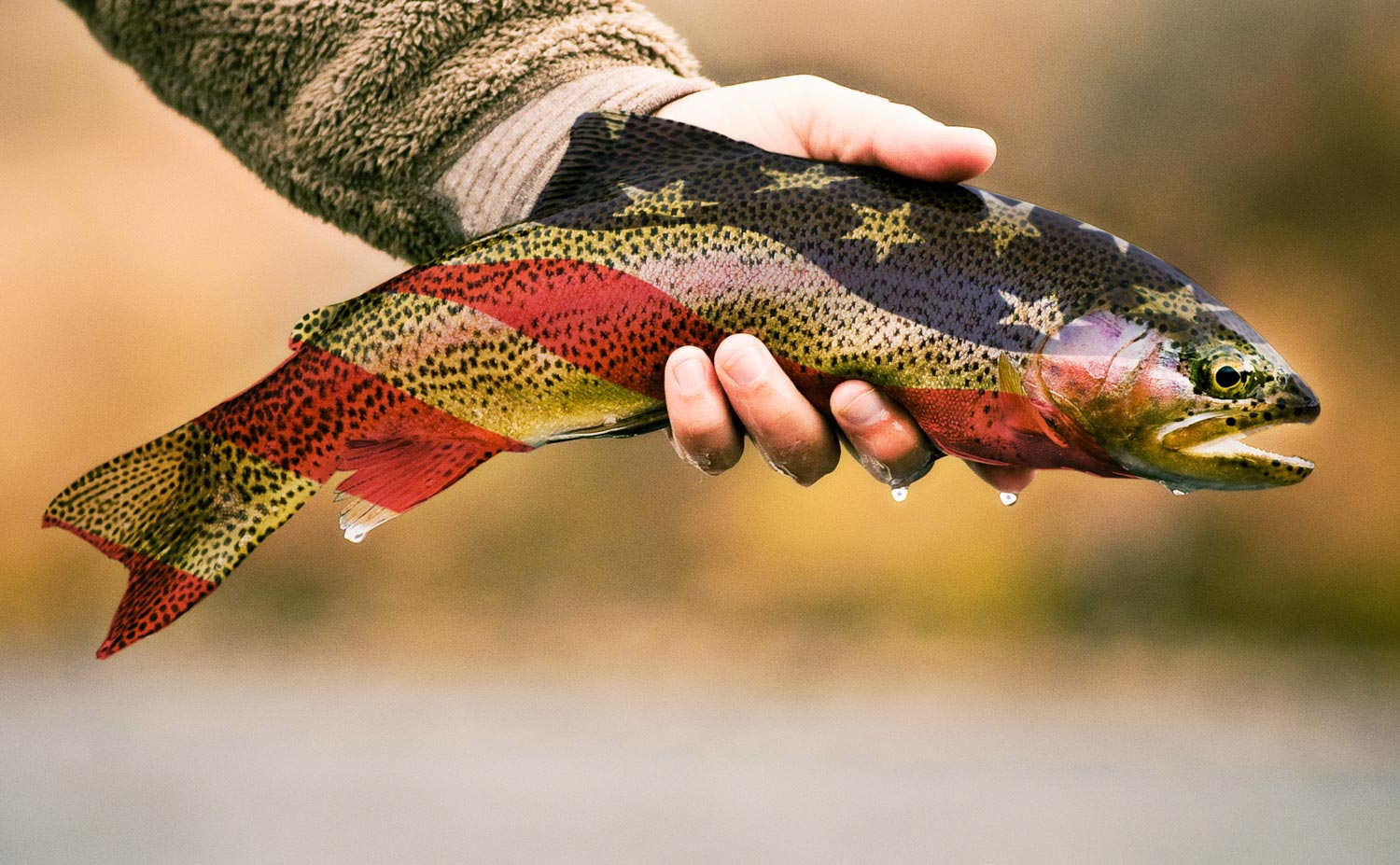
Let’s take a minute this July 4th to think about what we have.
The image you see here is one of my most popular. I regularly get emails about it. Folks commonly download it and plaster it on their Facebook pages. It seems that every US based angler who sees it has a visceral response. Why do you think that is?
I think it’s pride. Here in the US we anglers have a lot to be proud of. I have fished all over the world and I can tell you that we have a remarkable and unique resource here at home. We have water and land that make anglers around the world envious. The thing with makes me the proudest of my homeland is our vast public lands. Like those anglers who email me about my photo, I too have a profound and visceral response. I think we should all be proud of what we have and what we have been able to keep. It’s a very rare thing in this world and it sets our country apart.
Problem is, we aren’t doing a very good job of looking after it. We take it for granted. We neglect it and we are, at this point in our nations history, the closest we have ever been to losing it. That’s not something we should be proud of. Ask yourself this. Do you want to be part of the generation who lost our public lands? If not, you’d better start doing something about it.
So let’s take a minute this Independence Day and ask ourselves if we are proud. Are we proud of our heritage? Proud of our country? Proud of our public lands? Most importantly, are we proud of what we have done to protect and preserve them. Take that seriously and be honest. It’s easy to put your chest out and say you’re a proud American. It’s not so easy to do something for America that you can be proud of.
HAPPY INDEPENDENCE DAY FROM GINK AND GASOLINE
Read More »Sunday Classic / Weight is Great

I’ve hesitated to write on this topic because it seems so elementary. Sort of a fly fishing truism but I’ve been encouraged lately after reminding several of my friends who are highly experienced anglers of this simple fact. If you’re fishing nymphs for trout and you’re not catching fish, the odds are very good that you aren’t using enough weight.
My split shot gets me laughed at. Fly fishermen have ideas about weight. I carry a box of the polite little split shot, made for fly fishermen, but I seldom use them. I go straight to the stuff made for the gear guys. I carry size B and BB but I also carry #7 (1/4 inch diameter) and I’m not afraid to use them. On several occasions lately I’ve been fishing with friends and come to deep runs where neither of us have been able to find fish. After we each fished the run thoroughly, I added one of those #7 shot to my rig and caught a fish on the first cast.
The fish are there in those deep runs but in the early spring with water temps still low, they’re hugging the bottom. They’ll eat a fly, they just won’t move for it. You have to put it right on their nose. It’s a changeling way to fish and dealing with heavy rigs requires making some adjustments to your casting but it gets results. I’ve always thought that the art of fly fishing is in showing the fish what he wants, not expecting him to eat what we want to fish. That often involves weight, lots of it.
The other day I found myself fishing a rig consisting of:
Read More »Saturday Shoutout / Wicked Mr Pickett
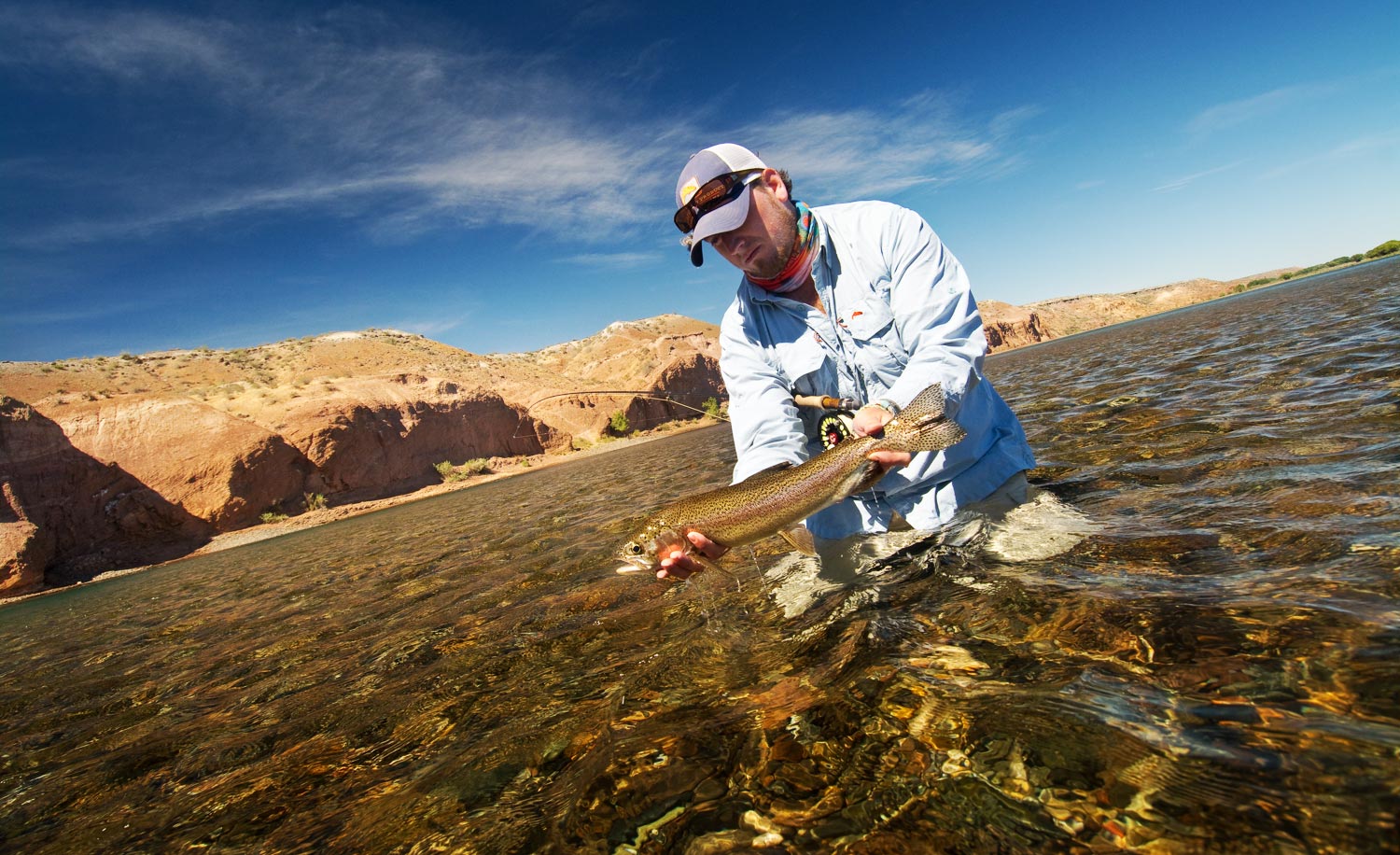
Get to know Justin Pickett on the Guided Lines Podcast.
If you read Gink and Gasoline you know the name Wicked Justin Pickett from his awesome articles and videos. You likely don’t know just how hard he works to help G&G reach all of our fans on social media. If you follow us on Facebook, Twitter or Instagram, that’s Justin.
He’s also a badass guide a dedicated dad and literally saves lives in his spare time. It’s about time he got some recognition. So if you’d like to take a few minutes and get to know Wicked Mr. Pickett, check out the podcast he recorded with Guided Lines podcast.
CLICK HERE FOR WICKED MR PICKETT
Read More »